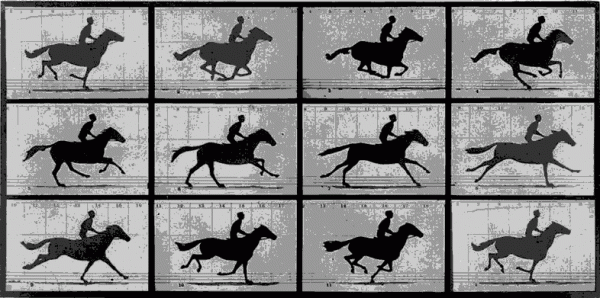By Sajeeb Sarker
Persistence of Vision
Media School June 18, 2020

Running Horse in 16 fps. Shot in 1878 by Eadweard Muybridge.
Persistence of vision is popularly explained as an optical illusion. If a person is presented by a sequence of still images in quick enough succession, the person (viewer) infer the whole exposure of that particular sequence as a single unit of 'moving' footage or a continuous and moving image making it felt like what we call a movie or film. This happens for brain's memory system; when you see a still image, the brain remembers it for a certain friction of time and it continues to happen for all the images presented in a particular sequence thus making it a 'moving image' that is called a film.
Persistence of vision needs both eye and brain to work properly. Scientists believe that the human eye and brain can process only 10 to 12 separate images per second. And the human brain retains that is remembers that particular image for up to a fifteenth of a second. And a series of still images are presented in a subsequent order making it a single sequence, the brain remembers the previous image (for up to a fifteenth of a second) even after the exposure of a new image replaces the earlier making it the illusion of continuity.
Technically speaking, persistence of vision actually occurs for the capacity of the eye to maintain an image on the retina for a brief period of time after the image disappears. If successive images follow in precise momentum, all these images will be perceived as a single image that is moving continuously. So, it is obvious that films in fact consist of a series of still images (identified as frames).
In easy words, we can explain persistence of vision as the retention of an image for a short span of time essentially after the removal of the stimulus (that very image) that created it. Thus, motion pictures are actually that particular phenomenon: illusion of movement. Mainly film theorists popularized this illusion of movement as the persistence of vision. This illusion is often expressed as 'retinal persistence' or 'persistence of impressions' as well.
In essence, our mind can perceive a quick succession of continuous still images as a moving image. In the early days of the invention of films, the assumption was that it will take 16 still pictures in a second to give an appearance of moving image to the viewer. Using 10 frames in a second is also capable of making that happen, but it would have jerky movie effect. In the early days, films were made with 16 frames per second (16fps); but after the sound films were introduced, films were ideally shot 24 frames per second to accommodate sound tracks.


